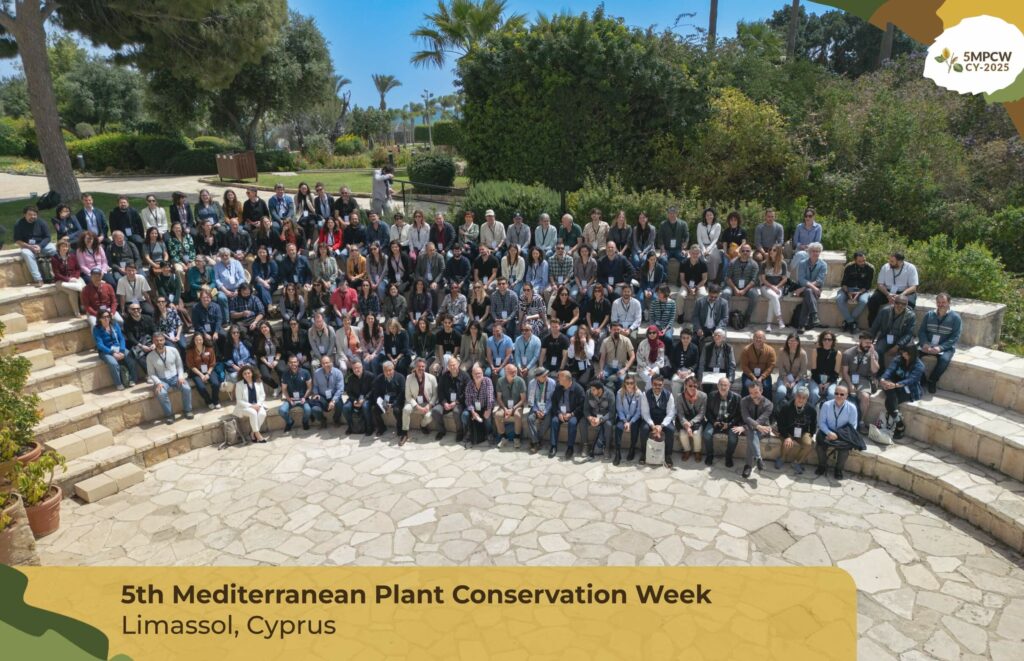
From April 7 to 11, 2025, the 5th Mediterranean Plant Conservation Week (5MPCW) took place in Limassol, Cyprus. This international event was organized by Frederick University (Cyprus), the Ministry of Agriculture, Rural Development, and Environment of Cyprus, the Critical Ecosystem Partnership Fund (CEPF), and the IUCN. The symposium welcomed almost 180 participants from 27 countries based in or conducting research in the Mediterranean region, which encompasses southern Europe, northern Africa, and the Middle East. The fifth symposium built upon the success of previous meetings, aiming to bring together experts in Mediterranean flora research and conservation. The event also served as a platform for sharing experiences, building and fostering collaboration between scientists and professionals from different disciplines.
Presentations covered a broad spectrum of topics, which were addressed in several thematic sessions. These included in situ and ex situ plant diversity conservation, restoration and management of Mediterranean habitats and ecosystems, the use of genetic tools and bioinformatics for plant conservation, the involvement of civil society in conservation projects, as well as approaches and techniques to combat alien and invasive species. The conference also featured an excursion to the Troodos mountains. This mountain range, reaching an altitude of nearly 2,000 meters, is home to unique habitats and endemic species. The field excursion provided participants with the opportunity to observe diverse habitats such as peat grasslands, serpentinophilous grasslands, forests of black and Calabrian pines (Pinus nigra, Pinus brutia) and the enigmatic golden oak (Quercus alnifolia), as well as riverbed habitats dominated by plane trees, alders, and ivy. They also visited the Troodos Botanical Garden, situated in the restored asbestos mine of Amiantos at 1,400 meters above sea level. The garden is dedicated to the native endemic flora and serves as a center for nature conservation, houses a herbarium and seed bank, while also playing a key role in environmental education. The exhibition in the garden also documents the process of the successful restoration of a heavy metal mining site.
Participants from CBRB SAV presented and discussed their research on rare and endemic Mediterranean species, uncovering and monitoring their genetic diversity, discovering and deciphering cryptic diversity, and pointing to the growing vulnerability of endemic flora due to habitat degradation and interspecific hybridization:
Fiškalović M., Zozomová-Lihová J., Lazarević P., Šlenker M., Šinžar-Sekulić J., Lazarević M. How can we help a threatened plant species to survive – a case study of Cardamine serbica. (talk)
Zozomová-Lihová J., Šlenker M., Šingliarová B., Mandáková T., Kantor A., Majerová H., Marhold K. Are Mediterranean mountain endemics threatened by hybridization with widespread congeners? Cautionary case studies on Cardamine apennina and C. rivularis. (talk)
Šlenker M., Bačák R., Šingliarová B., Skokanová K., Mandáková T., Kantor A., Majerová H., Zozomová-Lihová J. Revealing cryptic diversity and evolutionary processes in Erysimum species endemic to the western Balkan Peninsula. (poster)
Text: Judita Zozomová
Photo: Judita Zozomová, Richard Bačák
The presentations were supported by the EU NextGenerationEU through the Recovery and Resilience Plan for Slovakia under the project No. 09I03-03-V04-00489 and No. 09I03-03-V04-00494.









